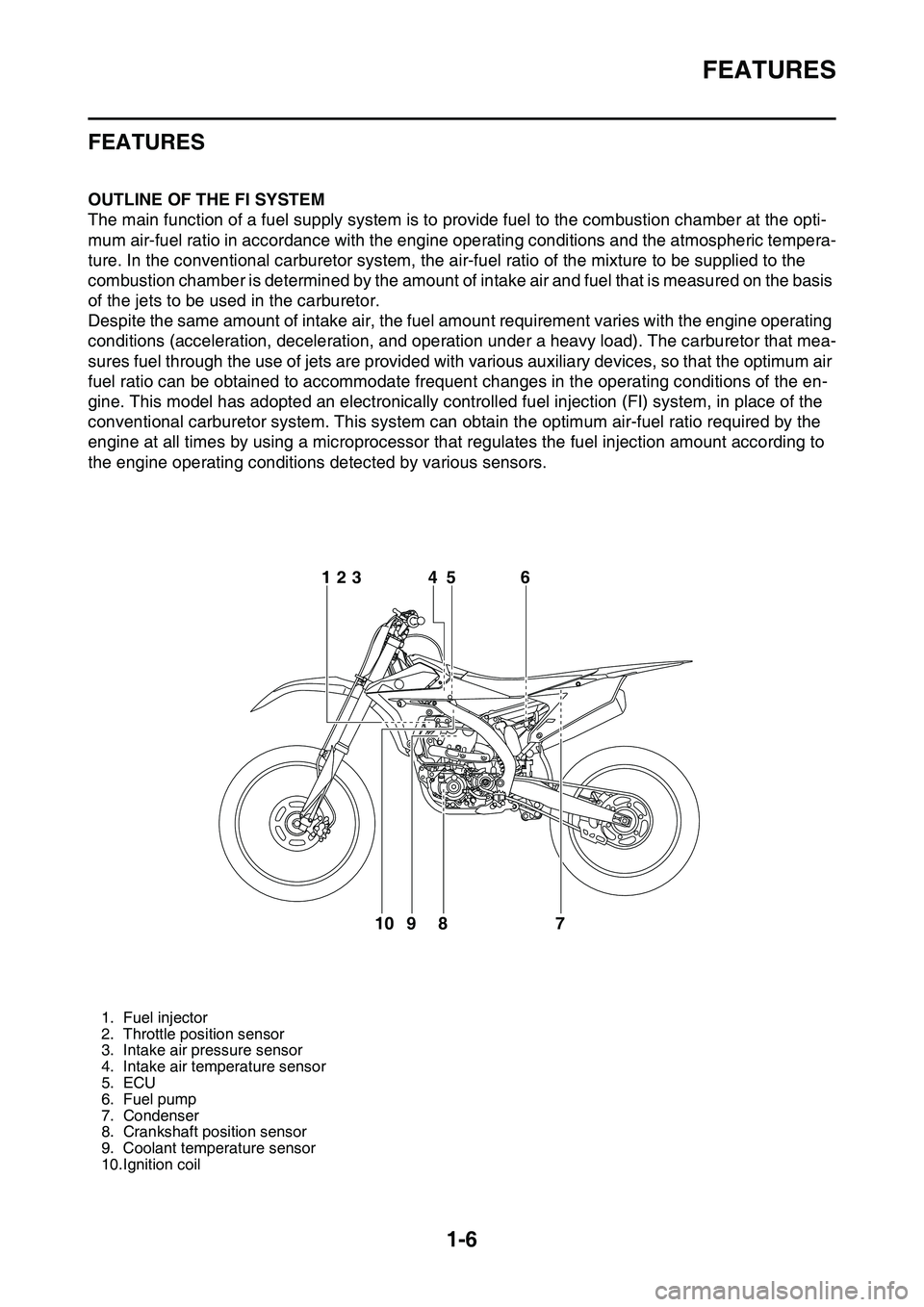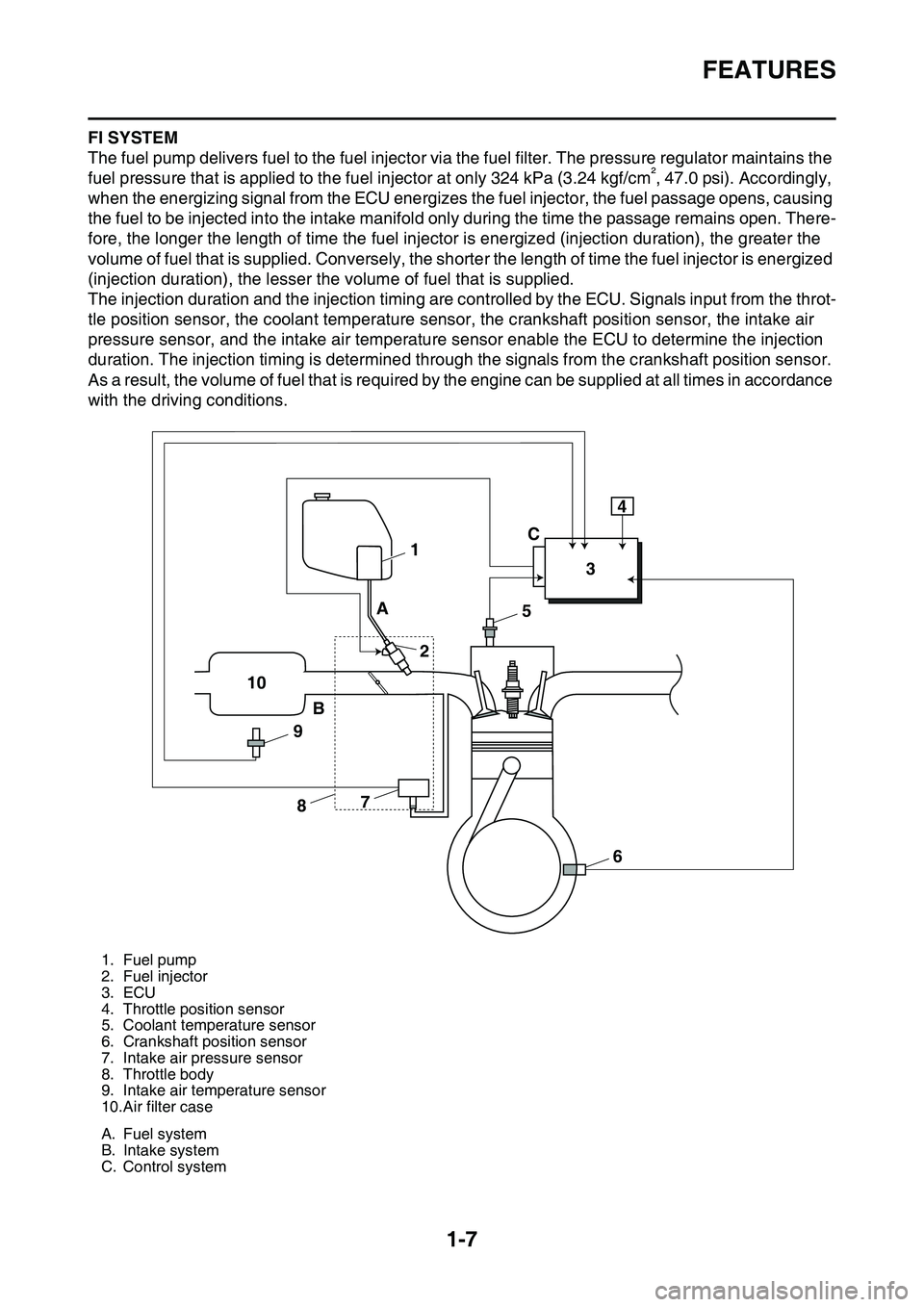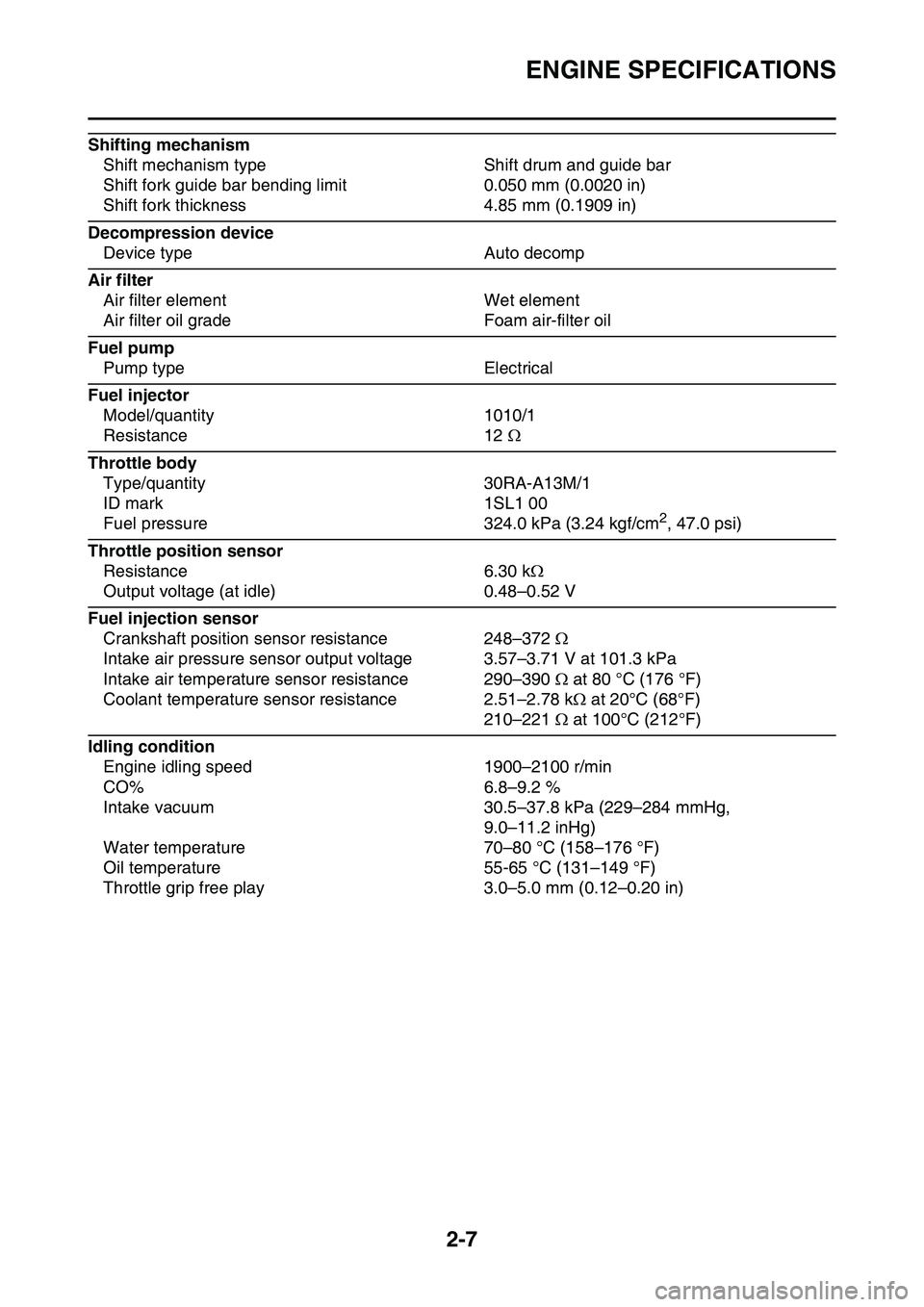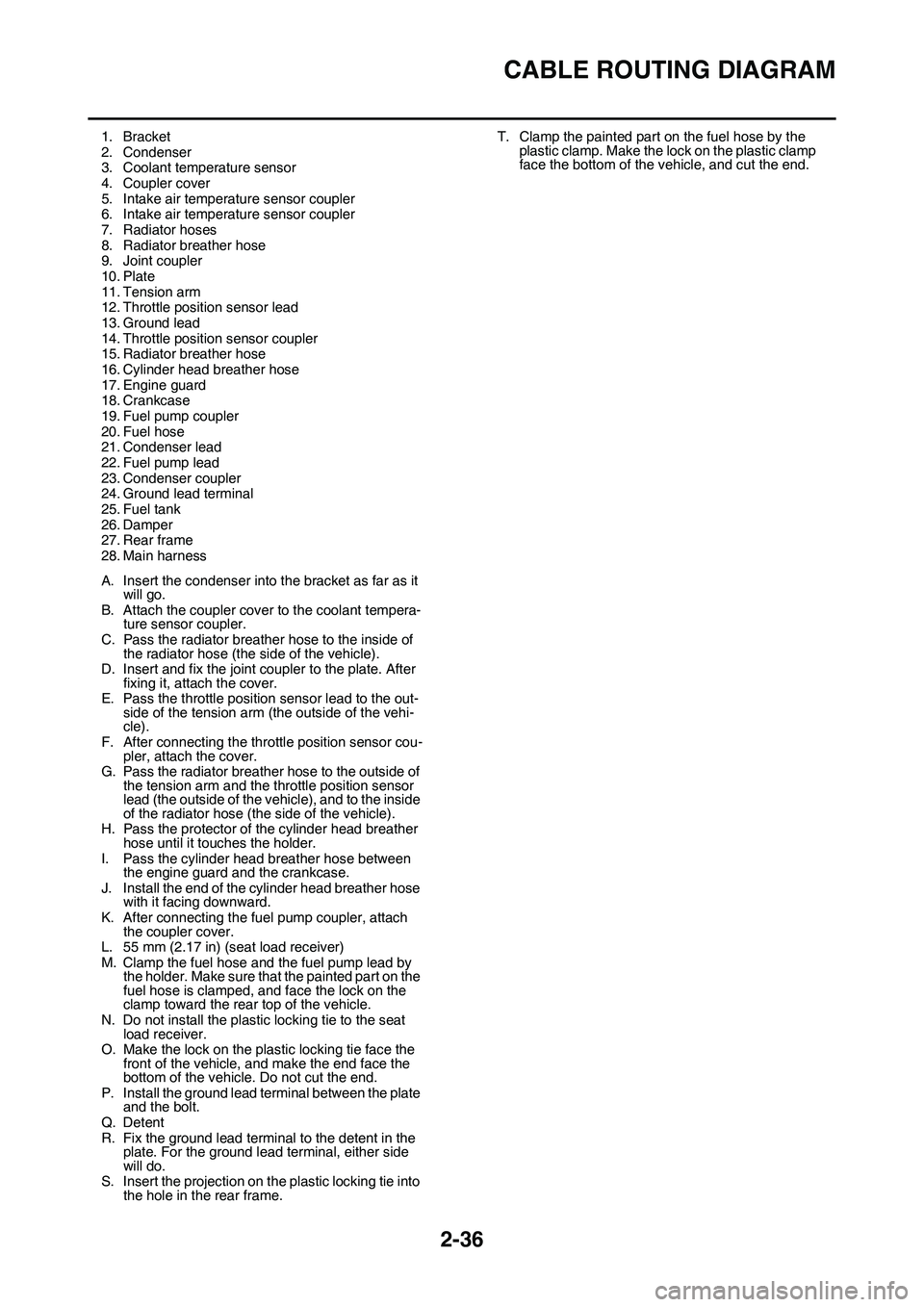2014 YAMAHA YZ450F fuel pump
[x] Cancel search: fuel pumpPage 20 of 360

FEATURES
1-6
EAS20170
FEATURES
EAS1SL1014OUTLINE OF THE FI SYSTEM
The main function of a fuel supply system is to provide fuel to the combustion chamber at the opti-
mum air-fuel ratio in accordance with the engine operating conditions and the atmospheric tempera-
ture. In the conventional carburetor system, the air-fuel ratio of the mixture to be supplied to the
combustion chamber is determined by the amount of intake air and fuel that is measured on the basis
of the jets to be used in the carburetor.
Despite the same amount of intake air, the fuel amount requirement varies with the engine operating
conditions (acceleration, deceleration, and operation under a heavy load). The carburetor that mea
-
sures fuel through the use of jets are provided with various auxiliary devices, so that the optimum air
fuel ratio can be obtained to accommodate frequent changes in the operating conditions of the en
-
gine. This model has adopted an electronically controlled fuel injection (FI) system, in place of the
conventional carburetor system. This system can obtain the optimum air-fuel ratio required by the
engine at all times by using a microprocessor that regulates the fuel injection amount according to
the engine operating conditions detected by various sensors.
EAS1SL1015
1. Fuel injector
2. Throttle position sensor
3. Intake air pressure sensor
4. Intake air temperature sensor
5. ECU
6. Fuel pump
7. Condenser
8. Crankshaft position sensor
9. Coolant temperature sensor
10.Ignition coil
6
7 8 95 4 123
10
Page 21 of 360

FEATURES
1-7
FI SYSTEM
The fuel pump delivers fuel to the fuel injector via the fuel filter. The pressure regulator maintains the
fuel pressure that is applied to the fuel injector at only 324 kPa (3.24 kgf/cm², 47.0 psi). Accordingly,
when the energizing signal from the ECU energizes the fuel injector, the fuel passage opens, causing
the fuel to be injected into the intake manifold only during the time the passage remains open. There
-
fore, the longer the length of time the fuel injector is energized (injection duration), the greater the
volume of fuel that is supplied. Conversely, the shorter the length of time the fuel injector is energized
(injection duration), the lesser the volume of fuel that is supplied.
The injection duration and the injection timing are controlled by the ECU. Signals input from the throt-
tle position sensor, the coolant temperature sensor, the crankshaft position sensor, the intake air
pressure sensor, and the intake air temperature sensor enable the ECU to determine the injection
duration. The injection timing is determined through the signals from the crankshaft position sensor.
As a result, the volume of fuel that is required by the engine can be supplied at all times in accordance
with the driving conditions.
1. Fuel pump
2. Fuel injector
3. ECU
4. Throttle position sensor
5. Coolant temperature sensor
6. Crankshaft position sensor
7. Intake air pressure sensor
8. Throttle body
9. Intake air temperature sensor
10.Air filter case
A. Fuel system
B. Intake system
C. Control system
1
234
5
6 7
8 9 10A
BC
Page 36 of 360

STARTING AND BREAK-IN
1-22
EAS1SL1041
STARTING AND BREAK-IN
EAS1SL1042FUEL
Always use the recommended fuel as stated
below. Also, be sure to use new gasoline the
day of a race.
JCA
NOTICE
Use only unleaded gasoline. The use of
leaded gasoline will cause severe damage
to the engine internal parts such as valves,
piston rings, and exhaust system, etc.
TIP
Your Yamaha engine has been designed to use
premium unleaded gasoline with a pump oc
-
tane number [(R+M)/2] of 91 or higher, or a re-
search octane number of 95 or higher. If
knocking (or pinging) occurs, use a gasoline of
a different brand.
JWA
WARNING
• For refueling, be sure to stop the engine
and use enough care not to spill any fuel.
Also be sure to avoid refueling close to a
fire.
• Refuel after the engine, exhaust pipe, etc.
have cooled off.
Gasohol (For USA and Canada)
There are two types of gasohol: gasohol con-
taining ethanol and that containing methanol.
Gasohol containing ethanol can be used if the
ethanol content does not exceed 10%. Gasohol
containing methanol is not recommended by
Yamaha because it can cause damage to the
fuel system or vehicle performance problems.
EAS1SL1043STARTING A COLD ENGINE
1. Press the shift pedal to neutral.
2. Pull the starter knob/idle screw “1” to its full
length.
TIP
When the ambient temperature is 15°C (59°F)
or below, use the starter knob/idle screw.
3. Push down the kickstarter lever lightly until
resistance is felt.
4. Fully close the throttle, and push down the
kickstarter lever in a stroke.
5. Immediately release the kickstarter lever.EWA
WARNING
Do not open the throttle at the moment
when you kick the kickstarter lever, be
-
cause this may kick back
TIP
If it fails to start, fully open the throttle grip and
give 10 to 20 slow kicks to clear the engine of
the rich air-fuel mixture retained in it.
6. When the engine starts running, warm this
up one or two minutes at a steady speed (of
3,000 to 5,000 r/min), and then return the
starter knob/idle screw to its original posi
-
tion.
EWA
WARNING
Since exhaust gas contains harmful ingre-
dients, do not start or warm it up at an ill-
ventilated place or a closed narrow place.
Recommended fuel
Premium unleaded gasoline
Fuel tank capacity
7.5 L (1.98 US gal, 1.7 lmp gal)
1
Page 39 of 360

TORQUE-CHECK POINTS
1-25
EAS1SL1048
TORQUE-CHECK POINTS
Frame constructionFrame to rear frame
Frame to engine protector
Combined seat and fuel tankFuel tank to frame
Engine mountingFrame to engine
Engine bracket to engine
Engine bracket to frame
SeatSeat to frame
SteeringSteering stem to handlebarSteering stem to frame
Steering stem to upper bracket
Upper bracket to handlebar
SuspensionFrontSteering stem to front forkFront fork to upper bracket
Front fork to lower bracket
RearLinkAssembly of links
Link to frame
Link to rear shock absorber
Link to swingarm
Mounting of rear shock absorberRear shock absorber and frame
Mounting of swingarmTightening of pivot shaft
Wheel (s)Mounting of wheelFrontTightening of wheel axle
Tightening of axle holder
Tightening of spoke nipple
RearTightening of wheel axle
Wheel to rear wheel sprocket
Tightening of spoke nipple
Brake(s)FrontBrake caliper to front fork
Brake disc to wheel
Tightening of union bolt
Brake master cylinder to handle-
bar
Tightening of bleed screw
Tightening of brake hose holder
RearBrake pedal to frame
Brake disc to wheel
Tightening of union bolt
Brake master cylinder to frame
Tightening of bleed screw
Tightening of brake hose holder
Fuel systemFuel pump to fuel tank
Page 45 of 360

ENGINE SPECIFICATIONS
2-2
EAS1SL1053
ENGINE SPECIFICATIONS
Engine
Engine type Liquid cooled 4-stroke, DOHC
Displacement 449 cm3
Cylinder arrangement Single cylinder
Bore stroke 97.0 60.8 mm (3.82 2.39 in)
Compression ratio 12.50:1
Starting system Kickstarter
Fuel
Recommended fuel Premium unleaded gasoline only
Fuel tank capacity 7.5 L (1.98 US gal, 1.65 Imp.gal)
Engine oil
Lubrication system Wet sump
Recommended brand YAMALUBE
Type SAE 10W-30, SAE 10W-40, SAE 15W-40,
SAE 20W-40 or SAE 20W-50
Recommended oil grade API service SG type or higher,
JASO standard MA
Engine oil quantity
Quantity (disassembled) 0.95 L (1.00 US qt, 0.84 Imp.qt)
With oil filter element replacement 0.69 L (0.73 US qt, 0.61 Imp.qt)
Without oil filter element replacement 0.67 L (0.71 US qt, 0.59 Imp.qt)
Oil filter
Oil filter type Paper
Oil pump
Oil pump type Trochoid
Inner-rotor-to-outer-rotor-tip clearance Less than 0.150 mm (0.0059 in)
Limit 0.20 mm (0.0079 in)
Outer-rotor-to-oil-pump-housing clearance 0.13–0.18 mm (0.0051–0.0071 in)
Limit 0.24 mm (0.0094 in)
Oil-pump-housing-to-inner-and-outer-rotor
clearance 0.06–0.11 mm (0.0024–0.0043 in)
Limit 0.17 mm (0.0067 in)
Cooling system
Radiator capacity (including all routes) 1.04 L (1.10 US qt, 0.92 Imp.qt)
Radiator capacity 0.57 L (0.60 US qt, 0.50 mp.qt)
Radiator cap opening pressure 108–137 kPa (1.08–1.37 kg/cm2 15.7–19.9 psi)
Radiator core
Width 112.6 mm (4.43 in)
Height 235.0 mm (9.25 in)
Depth 28.0 mm (1.10 in)
Water pump
Water pump type Single suction centrifugal pump
Spark plug
Manufacturer/model NGK/CR8E
Spark plug gap 0.7–0.8 mm (0.028–0.031 in)
Page 50 of 360

ENGINE SPECIFICATIONS
2-7
Shifting mechanism
Shift mechanism type Shift drum and guide bar
Shift fork guide bar bending limit 0.050 mm (0.0020 in)
Shift fork thickness 4.85 mm (0.1909 in)
Decompression device
Device type Auto decomp
Air filter
Air filter element Wet element
Air filter oil grade Foam air-filter oil
Fuel pump
Pump type Electrical
Fuel injector
Model/quantity 1010/1
Resistance 12
Throttle body
Type/quantity 30RA-A13M/1
ID mark 1SL1 00
Fuel pressure 324.0 kPa (3.24 kgf/cm2, 47.0 psi)
Throttle position sensor
Resistance 6.30 k
Output voltage (at idle) 0.48–0.52 V
Fuel injection sensor
Crankshaft position sensor resistance 248–372
Intake air pressure sensor output voltage 3.57–3.71 V at 101.3 kPa
Intake air temperature sensor resistance 290–390 at 80 °C (176 °F)
Coolant temperature sensor resistance 2.51–2.78 k at 20°C (68°F)
210–221 at 100°C (212°F)
Idling condition
Engine idling speed 1900–2100 r/min
CO% 6.8–9.2 %
Intake vacuum 30.5–37.8 kPa (229–284 mmHg,
9.0–11.2 inHg)
Water temperature 70–80 °C (158–176 °F)
Oil temperature 55-65 °C (131–149 °F)
Throttle grip free play 3.0–5.0 mm (0.12–0.20 in)
Page 63 of 360

TIGHTENING TORQUES
2-20
TIP
1. First, tighten the lower ring nut approximately 38 Nm (3.8 m·kgf, 27 ft·lbf) by using the steering nut
wrench, then loosen the lower ring nut one turn.
2. Retighten the lower ring nut 7 Nm (0.7 m·kgf, 5.1 ft·lbf).
Drive chain support nutM627 Nm (0.7 m·kgf, 5.1 ft·lbf)
Drive chain guide boltM534.0 Nm (0.40 m·kgf, 2.9 ft·lbf)
Rear frame and left cover boltM627 Nm (0.7 m·kgf, 5.1 ft·lbf)
Fuel tank bolt (front side)M627 Nm (0.7 m·kgf, 5.1 ft·lbf)
Fuel tank bolt (rear side)M619 Nm (0.9 m·kgf, 6.5 ft·lbf)
Fuel tank bracket bolt (front side)M647 Nm (0.7 m·kgf, 5.1 ft·lbf)
Fuel tank bracket bolt (rear side)M627 Nm (0.7 m·kgf, 5.1 ft·lbf)
Fuel pump boltM564.0 Nm (0.40 m·kgf, 2.9 ft·lbf)
Fuel inlet pipe screwM523.4 Nm (0.34 m·kgf, 2.5 ft·lbf)
Fuel tank cap cover boltM624.0 Nm (0.40 m·kgf, 2.9 ft·lbf)
Seat set bracket and fuel tank screwM617 Nm (0.7 m·kgf, 5.1 ft·lbf)
Seat boltM8222 Nm (2.2 m·kgf, 16 ft·lbf)
Left side cover boltM617 Nm (0.7 m·kgf, 5.1 ft·lbf)
Right side cover boltM627 Nm (0.7 m·kgf, 5.1 ft·lbf)
Frame and air scoop boltM627 Nm (0.7 m·kgf, 5.1 ft·lbf)
Fuel tank and air scoop boltM627 Nm (0.7 m·kgf, 5.1 ft·lbf)
Radiator guard and air scoop boltM647 Nm (0.7 m·kgf, 5.1 ft·lbf)
Front fender boltM6410 Nm (1.0 m·kgf, 7.2 ft·lbf)
Rear fender bolt (front side)M637 Nm (0.7 m·kgf, 5.1 ft·lbf)
Rear fender bolt (rear side)M6216 Nm (1.6 m·kgf, 12 ft·lbf)
Mud flap screw—21.3 Nm (0.13 m·kgf, 0.94 ft·lbf)
Number plate boltM617 Nm (0.7 m·kgf, 5.1 ft·lbf)
ITEMThread
sizeQ’ty TIGHTENING TORQUES Remarks
Page 79 of 360

CABLE ROUTING DIAGRAM
2-36
1. Bracket
2. Condenser3. Coolant temperature sensor
4. Coupler cover
5. Intake air temperature sensor coupler6. Intake air temperature sensor coupler
7. Radiator hoses
8. Radiator breather hose9. Joint coupler
10. Plate
11. Tension arm12. Throttle position sensor lead
13. Ground lead
14. Throttle position sensor coupler15. Radiator breather hose
16. Cylinder head breather hose
17. Engine guard18. Crankcase
19. Fuel pump coupler
20. Fuel hose21. Condenser lead
22. Fuel pump lead
23. Condenser coupler24. Ground lead terminal
25. Fuel tank
26. Damper27. Rear frame
28. Main harness
A. Insert the condenser into the bracket as far as it
will go.
B. Attach the coupler cover to the coolant tempera-ture sensor coupler.
C. Pass the radiator breather hose to the inside of
the radiator hose (the side of the vehicle).
D. Insert and fix the joint coupler to the plate. After
fixing it, attach the cover.
E. Pass the throttle position sensor lead to the out-side of the tension arm (the outside of the vehi-cle).
F. After connecting the throttle position sensor cou-pler, attach the cover.
G. Pass the radiator breather hose to the outside of
the tension arm and the throttle position sensor
lead (the outside of the vehicle), and to the inside
of the radiator hose (the side of the vehicle).
H. Pass the protector of the cylinder head breather
hose until it touches the holder.
I. Pass the cylinder head breather hose between
the engine guard and the crankcase.
J. Install the end of the cylinder head breather hose
with it facing downward.
K. After connecting the fuel pump coupler, attach
the coupler cover.
L. 55 mm (2.17 in) (seat load receiver)
M. Clamp the fuel hose and the fuel pump lead by
the holder. Make sure that the painted part on the
fuel hose is clamped, and face the lock on the
clamp toward the rear top of the vehicle.
N. Do not install the plastic locking tie to the seat
load receiver.
O. Make the lock on the plastic locking tie face the
front of the vehicle, and make the end face the
bottom of the vehicle. Do not cut the end.
P. Install the ground lead terminal between the plate
and the bolt.
Q. DetentR. Fix the ground lead terminal to the detent in the
plate. For the ground lead terminal, either side
will do.
S. Insert the projection on the plastic locking tie into
the hole in the rear frame.
T. Clamp the painted part on the fuel hose by the
plastic clamp. Make the lock on the plastic clamp
face the bottom of the vehicle, and cut the end.